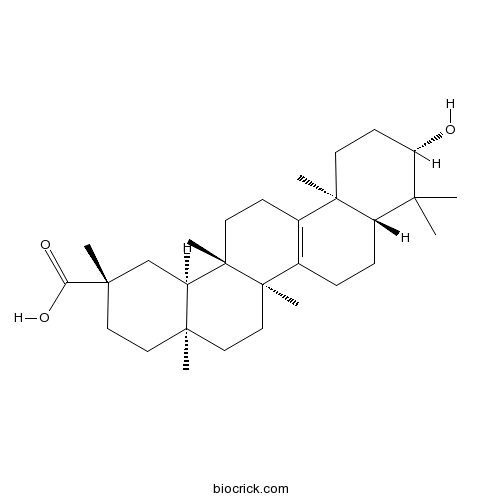A pentacyclic triterpenoid of D:C-friedooleanane-type triterpenoids isolated from the stems of Lagenaria siceraria and roots of Coriaria intermedia and has been found to exhibit antineoplastic activity.
InChI=1S/C30H48O3/c1-25(2)21-9-8-20-19(28(21,5)12-11-23(25)31)10-13-30(7)22-18-27(4,24(32)33)15-14-26(22,3)16-17-29(20,30)6/h21-23,31H,8-18H2,1-7H3,(H,32,33)/t21-,22+,23-,26+,27-,28+,29+,30-/m0/s1
Bryonolic acid(BA), isolated in high yield from transformed hairy root cultures of Trichosanthes kirilowii var. Japonica, it exhibits cytotoxic activity to various tumor cells in vitro, independent of cell type. [1]
Bryonolic acid can induce a marked increase in the expression of a phase 2 response enzyme, heme oxygenase 1 (HO-1), in a dose-dependent manner. [2]
Bryonolic acid can protect PC12 cells against NMDA-induced apoptosis by inhibiting Ca2+ influx and regulating gene expression in the Ca2+-CaMKII-CREB signal pathway, supports that BA may be a promising neuroprotective agent for the treatment of cerebral ischemia disease.[3]
Bryonolic acid has anti-inflammatory and antioxidant activities, can reduce the inflammatory mediator NO by suppressing the expression of the inflammatory enzyme inducible nitric oxide synthase (iNOS) in LPS-activated RAW 264.7 macrophage cells; can induce the antioxidant protein heme oxygenase-1 (HO-1) in vitro and in vivo in an Nrf2-dependent manner. [4]
Bryonolic Acid is an anti-allergic triterpene.[5]
English website: Bryonolic acid
Japanese website: Bryonolic acid
Chinese website: Bryonolic acid
[1] Kondo T, Inoue M, Mizukami H, et al. Biol Pharm Bull, 1995, 18(5):726-9.
[2] Barker E C, Gatbontonschwager T N, Han Y, et al. J Nat Prod, 2010, 73(6):1064-8.
[3] Que J, Ye M, Zhang Y, et al. Molecules, 2016, 21(4):418.
[4] Gatbonton-Schwager T N, Letterio J J, Tochtrop G P. J Nat Prod, 2012, 75(4):591-8.
[5] Tabata M, Tanaka S, Cho H J, et al. J Nat Prod, 1993, 56(2):165-74.
[6] Barker E C, Gatbontonschwager T N, Han Y, et al. J Nat Prod, 2010, 73(6):1064-8.



